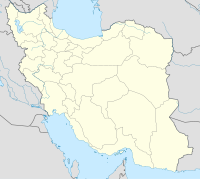Godin Tepe
| Godin Tepe | |
|---|---|
| Location in Iran | |
| Coordinates: 34°31′00″N 48°04′00″E / 34.51667°N 48.06667°E |
Godin Tepe is an archaeological site in western Iran, situated in the valley of Kangavar in Kermanshah Province. Discovered in 1961, the site was excavated from 1965 to 1973 by a Canadian expedition headed by T. Cuyler Young Jr. and sponsored by the Royal Ontario Museum (Toronto, Ontario, Canada). The importance of the site may have been due to its role as a trading outpost in the early Mesopotamian trade networks.
The earliest evidence for occupation at Godin comes from Periods XI through VII, spanning the Early and Middle Chalcolithic. The site was already inhabited as early as c. 5200 BC. Originally, the excavations concentrated on levels II (ended c. 500 BC?) to V (c. 3200 BC-3000 BC).
The earliest pottery is of the painted pottery traditions, including J ware (Godin pre-XI), and impressed Dalma ware (), belonging to Godin XI/X. J ware is related to Halaf culture pottery.
Level VIII is dated 4200-4000 BCE, contemporary with Terminal Ubaid period. According to Mitchell Rothman, at this time, during the Late Chalcolithic 1 period (LC 1), some substantial trading networks emerged in the area for trade in metals, and in precious or semi-precious stones,
"During the time of Godin VIII, the LC 1, a real increase in the movement of these goods is evident across the region. For example, lapis lazuli, a semi-precious blue stone known to occur naturally only in the Badakshan area of northeastern Afghanistan, began to appear in LC1 sites in significant amounts (Herman 1968)."
Thus, the importance of Godin Tepe may have been due to its position serving the early trade from the east, from as far as Afghanistan, and to the Mesopotamian flood plain. For example, lapis-lazuli was brought from Badakhshan in Afghanistan to Mesopotamia.
During the 1973 campaign, level V was excavated through a deep cut from the citadel. It was occupied during the period 3200 BC-3000 BC. At the end of level V there was a clear gap in the settlement sequence. There were signs of fire, such as room 22 whose roof was burned. The houses were in general well-preserved and contained many artefacts, but objects made of the precious metal were lacking. The archaeological evidence support the idea the settlement was abandoned quickly, but in an orderly manner.
...
Wikipedia

